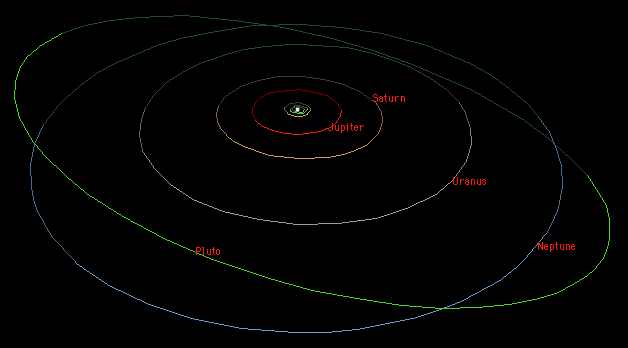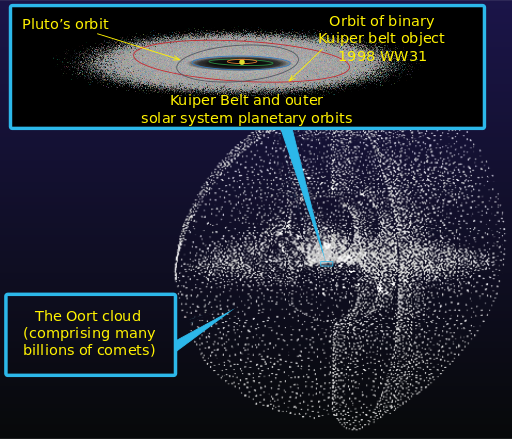Geography is a topic as vast as the Universe can get. Geography is study of Earth and other important things associated with the same. Before we study about our Earth in depth, let's have a peek in to where our abode stands in the endless Universe. Let's focus on the Solar System, it's position and composition and its limits and many more significant things.
Solar system is a simple system consisting of The Sun and other objects rotating the Sun. These objects are popularly classified as Planets, Moons, Asteroids, Comets and Dust Particles. Solar System is systematically located 26,000 light years away from the centre of Milky Way Galaxy. It is positioned in the Orion arm of the MilkyWay Galaxy. It is important to know that as the planets revolve around the Sun, Solar System revolves around the centre of the Galaxy.
Sun:
Sun is the centre of the solar system and the sole light-emitter. No other object in the solar system radiates. But they do absorb and adequately make use of the sun's radiation. Sun's plasma radiates only up to several thousand lightyears away from its surface. The sphere i.e., the space which can feel the propagation of sun's radiation/plasma is called Heliosphere. All the Planets, Moons, Asteroids, Comets and the Dust Particles are inside this giant sphere of sun's plasma. The intensity of radiation decreases as we travel farther from the surface of the Sun(That's why Mercury is the hottest planet and Neptune is the Coldest). Everything inside this sphere is called the solar system. Everything outside is called the Interstellar Space. The layer between the heliosphere and the Interstellar space is called Heliopause. Heliopause is the portion where the sun's plasma wind has equal speed as that of the winds of the Interstellar space, nullifying each other and ending the Heliosphere.
Planets:
After the Sun, next heavy objects in the Solar System are the Planets. International Astronomical Union in 2006 defined a planet as an object:
To name the planets in order of their distance from the Sun:
Mercury, Venus, Earth, Mars, Jupiter, Saturn, Uranus, Neptune. As mentioned earlier, the temperature of the planets decreases with increasing distance from the Surface of the Sun. Ergo, Mercury is hottest and Neptune is icy. Mercury, Venus, Earth, Mars are called the inner-terrestrial or the terrestrial planets as they are comparatively nearer to the Sun. After mars there is a continuous belt of space filled with asteroids. This belt is called The Asteroid Belt.
The Planets coming after the Asteroid Belt are called the Outer-Terrestrial planets or the Giant planets(For their size). Giant Planets: Jupiter, Saturn, Uranus, Neptune are so large in size and mass that their combined mass constitutes 99% of the mass of the Solar System(excluding Sun). Further, Jupiter and Saturn are called the Gas Giants as they have high compositions of gases like hydrogen and the like. And Uranus and Neptune are called the Ice Giants as their surfaces are more dense and made of ice due to composition of nitrogen and ammonia besides hydrogen and the like.
Size and Mass and Density:
Sun is by default heaviest and the largest of all bodies in the Solar System.
By size Jupiter is the largest planet of the Solar System. The order will be: Jupiter, Saturn, Uranus, Neptune, Earth, Venus, Mars and Mercury.
By mass, as well, Jupiter is the heaviest planet of the Solar System. The order will be: Jupiter, Saturn, Neptune, Uranus, Earth, Venus, Mars and Mercury. Neptune has more mass even when it is smaller in size than Uranus due to its high density.
By density Earth is the densest planet of the Solar System. The order will be: Earth, Mercury, Venus, Mars, Neptune, Jupiter, Uranus, Saturn.
Moons or Natural Satellites:
Satellites are the objects that revolve around other Bodies or Planets. Like planets follow their orbit around the sun, satellites follow their orbit around the planet. Only primary satellite and non-artificial ones are called Natural Satellites. Basically satellites include very small(<10km diameter) objects which satisfy the definition of Asteroid as well. Natural Satellites are the primary ones and ONLY the primary ones. The ones that are predominantly large by mass.
Jupiter has 67 satellites including four natural satellites- Lo, Ganymede, Europa, Callisto.
Saturn has 63 satellites including seven natural satellites- Titan, Lapetus, Dlone, Tethys, Enceladus, Mimas and Rhea.
Uranus has 27 satellites including six natural satellites- Puck, Ariel, Titania, Oberon, Umbreil and Miranda (All names from the Works of Shakespeare).
Neptune has 13 satellites including one natural satellite Triton.
Mars has two satellites, Phobos (Meaning: Fear) and Deimos (Meaning: Dread).
Earth has only one satellite i.e., the Moon.
Mercury and Venus do not have any satellites.
Solar system is a simple system consisting of The Sun and other objects rotating the Sun. These objects are popularly classified as Planets, Moons, Asteroids, Comets and Dust Particles. Solar System is systematically located 26,000 light years away from the centre of Milky Way Galaxy. It is positioned in the Orion arm of the MilkyWay Galaxy. It is important to know that as the planets revolve around the Sun, Solar System revolves around the centre of the Galaxy.
Sun:
Sun is the centre of the solar system and the sole light-emitter. No other object in the solar system radiates. But they do absorb and adequately make use of the sun's radiation. Sun's plasma radiates only up to several thousand lightyears away from its surface. The sphere i.e., the space which can feel the propagation of sun's radiation/plasma is called Heliosphere. All the Planets, Moons, Asteroids, Comets and the Dust Particles are inside this giant sphere of sun's plasma. The intensity of radiation decreases as we travel farther from the surface of the Sun(That's why Mercury is the hottest planet and Neptune is the Coldest). Everything inside this sphere is called the solar system. Everything outside is called the Interstellar Space. The layer between the heliosphere and the Interstellar space is called Heliopause. Heliopause is the portion where the sun's plasma wind has equal speed as that of the winds of the Interstellar space, nullifying each other and ending the Heliosphere.
Planets:
After the Sun, next heavy objects in the Solar System are the Planets. International Astronomical Union in 2006 defined a planet as an object:
- Being in the orbit around the Sun.
- Having high gravitational forces and massive enough to overcome the rigid body forces and thus attaining Hydrostatic Equilibrium(spherical in shape).
- Being able to 'clear the space' around its orbit.
- Being as effective as other planets of the Solar System.
Spatial Positioning:
' Clearing the Space around the Orbit means, in the last stages of planet formation, the effective gravitational pull should be clearing the space around the orbit by pulling the objects in to its field. And the planet shall revolve around the Sun only along with its moons. If this criterion is missed, such an object will be called Dwarf-Planet.'
To name the planets in order of their distance from the Sun:
Mercury, Venus, Earth, Mars, Jupiter, Saturn, Uranus, Neptune. As mentioned earlier, the temperature of the planets decreases with increasing distance from the Surface of the Sun. Ergo, Mercury is hottest and Neptune is icy. Mercury, Venus, Earth, Mars are called the inner-terrestrial or the terrestrial planets as they are comparatively nearer to the Sun. After mars there is a continuous belt of space filled with asteroids. This belt is called The Asteroid Belt.
Asteroids / noun. They are the objects of space. They have comparatively (to planets) less mass, density. They do revolve around the Sun like planets do, but they lack Hydrostatic Equilibrium(Spherical Shape) most importantly the ability to clear the space around their orbit. However, at times, asteroids are pulled by larger planets like Neptune(due to their high gravitational pull) and are forced to revolve around the planets ultimately becoming their moons. Triton, one of the moons of Neptune is an example. It has been identified as a pulled object based on Triton's retrogade (they orbit in opposite direction of their planets rotation) movement around Neptune.
'Kuiper's Belt is similar to the asteroid belt but it is formed beyond the Neptunian orbit. Some loose asteroids or other objects which get pulled in to solar system from the belt travel fast and attain high speeds to form comets. Same is the case with some objects falling in to the Solar system from the Oort cloud near the Proxima Centauri(Closest star to the Sun).'
The Planets coming after the Asteroid Belt are called the Outer-Terrestrial planets or the Giant planets(For their size). Giant Planets: Jupiter, Saturn, Uranus, Neptune are so large in size and mass that their combined mass constitutes 99% of the mass of the Solar System(excluding Sun). Further, Jupiter and Saturn are called the Gas Giants as they have high compositions of gases like hydrogen and the like. And Uranus and Neptune are called the Ice Giants as their surfaces are more dense and made of ice due to composition of nitrogen and ammonia besides hydrogen and the like.
Size and Mass and Density:
Sun is by default heaviest and the largest of all bodies in the Solar System.
By size Jupiter is the largest planet of the Solar System. The order will be: Jupiter, Saturn, Uranus, Neptune, Earth, Venus, Mars and Mercury.
By mass, as well, Jupiter is the heaviest planet of the Solar System. The order will be: Jupiter, Saturn, Neptune, Uranus, Earth, Venus, Mars and Mercury. Neptune has more mass even when it is smaller in size than Uranus due to its high density.
By density Earth is the densest planet of the Solar System. The order will be: Earth, Mercury, Venus, Mars, Neptune, Jupiter, Uranus, Saturn.
Moons or Natural Satellites:
Satellites are the objects that revolve around other Bodies or Planets. Like planets follow their orbit around the sun, satellites follow their orbit around the planet. Only primary satellite and non-artificial ones are called Natural Satellites. Basically satellites include very small(<10km diameter) objects which satisfy the definition of Asteroid as well. Natural Satellites are the primary ones and ONLY the primary ones. The ones that are predominantly large by mass.
Jupiter has 67 satellites including four natural satellites- Lo, Ganymede, Europa, Callisto.
Saturn has 63 satellites including seven natural satellites- Titan, Lapetus, Dlone, Tethys, Enceladus, Mimas and Rhea.
Uranus has 27 satellites including six natural satellites- Puck, Ariel, Titania, Oberon, Umbreil and Miranda (All names from the Works of Shakespeare).
Neptune has 13 satellites including one natural satellite Triton.
Mars has two satellites, Phobos (Meaning: Fear) and Deimos (Meaning: Dread).
Earth has only one satellite i.e., the Moon.
Mercury and Venus do not have any satellites.
Ecliptic Plane:
All the Planet in the solar system revolve around the sun in their respective orbits. The plane of the orbit of the Earth around the Sun is called as the Ecliptic Plane. Almost all the planets have their orbit on the Ecliptic plane. Earth rotation is 23.5˚ inclined to the perpendicular of the ecliptic. The consequences of such inclination is the occurrence of seasons. We shall see more about the consequences of such inclinations in coming articles.
To know more about the Earth's atmosphere read, Around the Earth - Part I.
To know more about the Earth's atmosphere read, Around the Earth - Part I.



No comments:
Post a Comment